Who can be a candidate for bunion surgery in Iran?
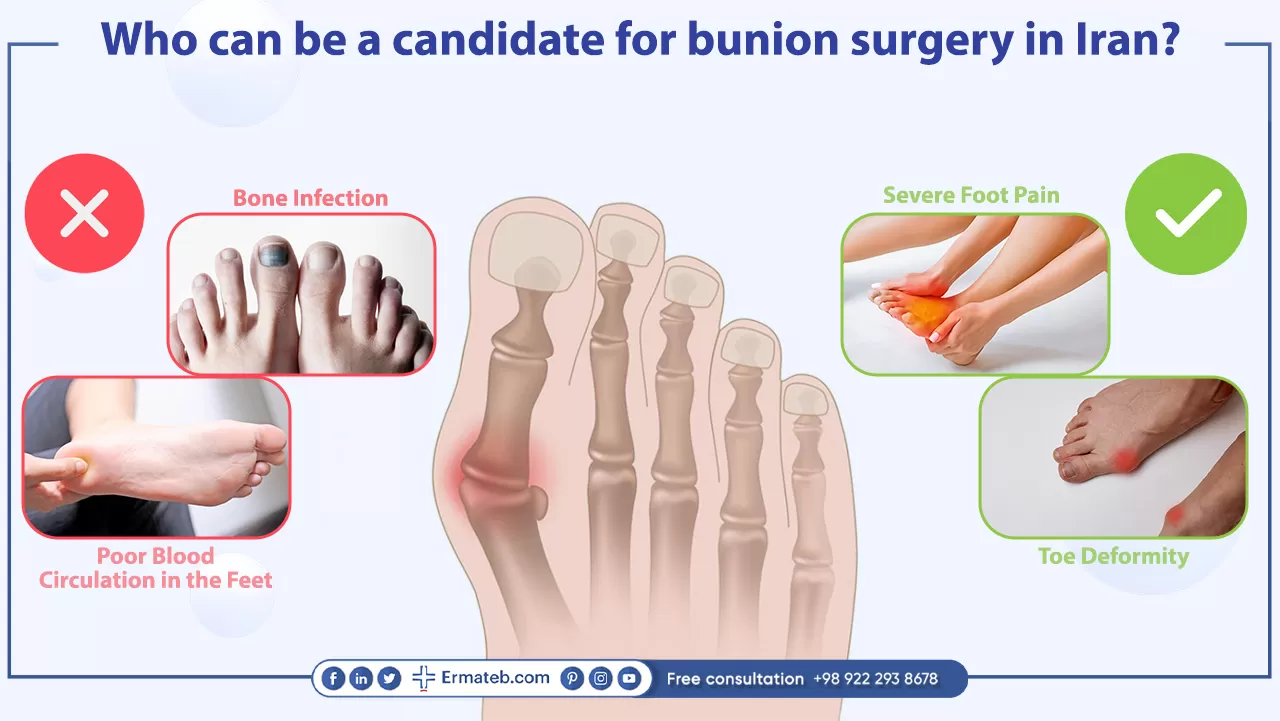
people may be good candidates for bunion surgery if they have:
1.Severe foot pain that limits their daily activities, like walking and wearing reasonable shoes.
2.If they have chronic big toe inflammation and swelling that doesn’t improve with rest or medications,
3.If they have a toe deformity or stiffness which affects their mobility.
Some people cannot have the bunion procedure because they have health conditions or circumstances that would make the surgery unsafe. People may not be a candidate for the bunion procedure if they have the following features:
1.Bone infection: bone infection, or osteomyelitis, is a serious condition that can cause complications during and after the procedure, like delayed healing, or spread of infection, or persistent pain.
2.Poor blood circulation in the feet: Poor blood circulation in the feet, like peripheral vascular disease, can affect the blood supply and oxygen delivery to the surgical site, which impairs wound healing and raises the risk of gangrene, infection, or amputation.
3.Severe arthritis of the affected joint in the big toe: It can limit the range of function and motion of the toe, making the procedure less effective or even harmful. In some cases, joint fusion or replacement can be an option instead of a bunion procedure.
4.Severe active infections: They can compromise the immune system and make the patient more prone to postoperative infections or side effects.
5.Insufficient blood supply: It can be caused by conditions like diabetes, which affects the process of healing and raises the risk of infection, nerve damage, or ulceration.
6.Unmotivated patient: It means that the patient is not willing or able to follow the postoperative instructions, like wearing a cast or boot, taking pain medications, using crutches or a walker, and doing physical therapy exercises. These are necessary for a successful recovery and result.
7.Patient with unreasonable expectations: It means that the patient has unrealistic hopes or goals for the operation, like expecting a cosmetic improvement, a return to high-impact activities, or a complete resolution of pain. Patients should know that Bunion surgery is not an aesthetic procedure and shouldn’t be done for cosmetic reasons. It’s only recommended for individuals who have significant pain or disability caused by their bunions.
Cost of bunion surgery ( Hallux valgus ) in Iran

For patients who cannot get their surgeries in their hometown and want to have their treatment overseas, the cost of the treatment is one of the important factors.
Bunion surgical procedures can cost as much as $20,000 per foot. We should mention that few countries offer quality bunion surgical procedures at affordable prices. Iran offers high-quality bunion treatment options at only a fraction of the cost found elsewhere in the world.
Ermateb is a medical tourism facilitator in Iran. You can contact us to get any information you want to know about having your bunion surgery in Iran, the exact cost ( 1200-2000 ) , the advantages and disadvantages of this procedure, and more.
Types of bunion surgery
There are many types of bunion surgery aiming to either reposition the bone, eliminate a part of the tissue, or realign ligaments. Some of these techniques and methods might be performed simultaneously for intense bunions.
The type of procedure that the surgeon wants to perform depends on some factors, including:
1. The shape and size of the patient’s bunion
2. The degree of pain and disability caused by the patient’s bunion
3. The condition of the other foot joints
4. The patient’s age and activity level
5. The patient’s personal preferences and expectations
6. The patient’s physical condition
The main techniques for bunion surgery are:
1.Osteotomy:
in this method, the surgeon cuts a part of the bone to realign the malpositioned joint. It is performed for moderate bunion cases and is done along with repositioning the ligaments. Once the joint is balanced, the break will be fixed using screws, pins, or plates. In some cases, some bone shaving is also done to eliminate the excess bone.
2.Exostectomy:
This technique refers to eliminating some excess bone from the inside of the foot. For optimal outcomes, exostectomy is usually performed with osteotomy.
3.Arthrodesis:
This type is primarily performed on intense or arthritic bunions. During the procedure, the surgeon eliminates the affected areas and uses screws or wires to hold the bones together during the healing process.
4.Ligament repairing:
It is a procedure to repair the ligaments and tendons that are causing an imbalance. In many cases, this technique is an adjunctive surgical procedure. By repairing the ligament, the surgeon can ensure the bunion doesn’t recur.
5.Joint replacement:
In rare cases, the joint inflammation is so intense that the surgeon has to eliminate the entire joint and use joint replacements instead.
Before deciding to undergo bunion surgery, patients should consult with an orthopedic surgeon to discuss their options and choose the best one for them. Patients should also be aware of the possible risks and side effects of bunion procedures, like bleeding, infection, nerve damage, recurrence of the bunion, or persistent pain. The patient should also be prepared for a long recovery time that may include wearing a cast or boot, taking pain medications, using crutches or a walker, and doing physical therapy exercises.
Before the bunion procedure
Tests and examinations are an essential part of every surgery. Before the procedure, the doctor may ask for the patient’s complete medical history and then perform many tests, including:
1.X-ray
2.Blood test
3.Electrocardiogram
4.Urine test
The patient might be advised to take certain measures before the procedure. These instructions may be different based on the physical condition and the type of bunion operation. The main tips the patient should follow before bunion operation are:
1.Refrain from alcohol and tobacco consumption for at least 2 weeks before the procedure.
2.Avoid taking blood thinners like anti-inflammatory medications.
3.The patient should inform the healthcare provider about the medications they are currently taking.
4.Don’t eat or drink anything for at least 8 hours before the operation.
How is bunion surgery performed?
The surgeon will select the surgical procedure suitable for the patient’s situation by examining the foot. Then, the patient will be asked to take some tests and prepare for the surgery.
The operation itself might take about one hour, but the patient will be asked to arrive at the medical center some hours earlier and stay for 2 hours after the procedure. When the operation is performed on both feet, also called a double bunionectomy, it could take more than one hour.
The first step of the procedure is anesthesia. Usually, ankle block anesthesia (keeping the patient wide awake while numbing the foot) is used for bunion removal procedures. ankle block anesthesia will keep the patient wide awake while numbing the foot. After that, the surgeon makes an incision over the lump on the joint of the big toe. Using the procedures mentioned above, the surgeon will then eliminate the bunion and reposition the bone alignment. afterward, the opening will be closed using stitches.
Advantages and disadvantages of bunion surgery in Iran
some of the pros and cons of bunion surgery are:
Advantages:
1.Bunion procedure can remove bunion pain significantly. This can improve the quality of life and allow the patient to be more physically active.
2.Bunion operation can also decrease the appearance of the bump at the base of the patient’s big toe. It can enhance self-confidence and comfort in wearing shoes.
3.The bunion procedure improves foot function by correcting the alignment of the big toe joint. It prevents further damage to the joint and other foot issues, like corns, hammertoes, or calluses.
4.A bunion procedure can shorten the recovery period than non-surgical treatments, like wearing splints or orthotics. Depending on the type of procedure, the patient may be able to walk and resume normal activities within a few weeks or months.
5.Bunion operation can decrease the risk of side effects like bleeding, infection, nerve damage, or recurrence of the bunion. This is especially true for minimally invasive bunion operation, which includes smaller incisions and less tissue damage.
Disadvantages:
1.Bunion procedure isn’t an aesthetic surgery and shouldn’t be done for aesthetic reasons alone. It’s only recommended for individuals who have substantial pain and disability caused by their bunions.
2.A bunion operation is not a guarantee that the bunions won’t come back or that the patient will have no pain or problems in the future. Some factors that may affect the result of the procedure include activity level, bone quality, age, and compliance with postoperative instructions.
3.Bunion procedures may have a higher price than non-surgical treatments, depending on the insurance coverage, type of operation, and hospital fees. The patient may also need to pay for additional expenses like pain medications, antibiotics, special shoes or orthotics, and physical therapy.
4.Bunion procedures may have a longer operating time compared to non-surgical treatments, depending on the severity and complexity of the bunion. This may raise the risk of anesthesia-related complications or blood loss.
5.Bunion procedure may be more difficult compared to non-surgical treatments, depending on the experience and skill of the patient’s surgeon. The patient may need to find a qualified and reputable surgeon who can perform the type of bunion operation that is best for them.
Risks and complications of bunion surgery
Like any surgical procedure, a bunion operation has some risks and side effects that one should be aware of before undergoing this operation. Some of the possible risks and side effects are:
1.Infection:
This is a rare but important side effect that affects the bone, the wound, or the surgical hardware that is used to stabilize the bone. Infection causes persistent pain, delayed healing, or spread of infection to other parts of the body. Infection may need additional operation, antibiotics, or removal of the hardware.
2.Recurrence of bunion:
It means that the bunion may come back after the operation, either in the same place or in a different location on the foot. Recurrence may be caused by improper surgical methods, inadequate correction of the underlying cause of the bunion, or failure to follow postoperative instructions. Recurrence may need another operation or non-surgical treatments.
3.Big toe joint stiffness:
It means that the range of function and motion of the big toe joint may be decreased following the procedure. Stiffness may be caused by arthritis, scar tissue formation, or malalignment of the bone. Stiffness can affect the ability to walk, run, or wear shoes. Stiffness can be improved by physical therapy exercises or another operation.
4.Nerve damage:
nerve damage means that the nerves near the surgical site may be damaged during the operation, causing burning, numbness, tingling, or pain in the toe or foot. It may be temporary or permanent. Nerve damage can affect the sensation and comfort of the foot. Nerve damage can be treated by medications or operation.
5.Blood clot:
it means that a blood clot may form in the leg veins after the procedure, causing pain, swelling, or redness in the leg. Blood clots can be dangerous if they travel to the lungs and cause a pulmonary embolism. Blood clots may need blood thinners or emergency treatment.
6.Other foot problems:
this means that other parts of the foot may become irritated or damaged following bunion procedure, like corns, hammertoes, calluses, or arthritis. Other foot issues may be caused by changes in the foot biomechanics, pressure from shoes, or overuse of the foot. Other foot issues may need additional treatments or operations.
These are some of the common risks and side effects of bunion operation. Patients should discuss with the surgeon about the benefits and risks of this surgery before undergoing bunion surgery. Patients should also follow their surgeon’s instructions to minimize the chances of risks and side effects and achieve the best possible result.
The recovery period of bunion surgery
The recovery process of a bunion operation depends on the complexity and type of the surgery, and the patient’s healing process. some general information about the recovery process of bunion operation is as:
1.Initial recovery from the bunion procedure takes about 6 weeks. During this time, the patient’s foot will start to heal from the surgical incision. Pain and swelling will reduce, and the patient will start to regain mobility.
2.The patient will need to wear a surgical boot or cast to protect her foot for the first 2 weeks following the surgery. She/he should avoid getting their stitches wet and follow the doctor’s instructions on how to care for their wound and change their dressing.
3.The patient will also need to limit the weight-bearing on their foot for some weeks following the surgery. The patient may need crutches or a walker to help them move around. They should keep their foot elevated as much as possible to decrease swelling and inflammation.
4.The patient will need to take painkillers and antibiotics as prescribed by the doctor to prevent infection and manage discomfort. The patient should also avoid alcohol, smoking, and anti-inflammatory medications that can interfere with healing.
5.The patient will need to do some physical therapy exercises to improve their range of motion and strength in the foot. the doctor or physical therapist will guide the patient on when and how to begin these exercises. They should also refrain from activities that put too much stress on the foot, like jumping, running, or wearing high heels.
6.Full recovery from a bunion operation can take an average of 4 to 6 months. During this time, the patient’s foot will heal completely and they will be able to resume their normal activities. They may also need to wear orthotics or special shoes to prevent bunions from coming back.
7.The patient will have to follow up with the doctor regularly for up to a year following the surgery to monitor their progress and results. The doctor will check the foot alignment, function, and appearance. the doctor will also advise the patient on how to prevent future bunions or complications.
Patients should consult with their surgeon about the specific details of their recovery plan and follow their instructions carefully. They should also report any signs of bleeding, infection, nerve damage, or recurrence of the bunion to their doctor as soon as possible.
Why should I get my bunion surgery in Iran?
In recent years, Iran has been a leading country in terms of both medical and cosmetic surgeries. There are many reasons that patients choose this country as their destination to get any kind of knee replacement.
One of the most important reasons is that this country offers its treatments and surgeries at high quality and low prices. The high number of applicants and the low currency of Iran against other countries are the reasons for low prices in Iran. Therefore, international patients can receive their medical treatments at reasonable prices and high quality.
One of the other reasons is that the best surgeons and doctors settle in Iran. Iranian surgeons and specialists have completed their education and courses in the top universities of the world, and also, they have performed many successful bunion surgeries in years.
Another point of having your surgery here is that you don’t have to wait to get your treatment for an unknown time since there are no waiting lists in this country.
Ermateb is a medical tourism facilitator located at the Iran University of Medical Science. Ermateb’s goal is to help international patients, especially those who come from the Middle East, to get the best quality of medical services easily in Iran. To arrange your bunion surgery in Iran, you can get in touch with us via WhatsApp, or you can fill out the online form on our website. After that, a personal coordinator will be arranged to guide you through the next process of your procedure. Our consultant may ask for your information and documents. Alongside your treatment, you can visit and enjoy the historical attractions of Iran.
Can bunions come back after the surgery?
Bunions can come back after the surgery, but it’s relatively rare and happens very gradually. they can come back after surgery for many reasons, including:
1.Inadequate correction of the underlying cause of the bunion, Improper surgical method, or failure to follow postoperative instructions.
2.Engaging in certain activities that can cause or accelerate the growth of bunions, like wearing tight-fitting shoes or holding the foot at unnatural angles for a long time.
3.Having a foot shape that predisposes the person to bunions, which may not be fully corrected by operation.
4.Developing conditions like arthritis that may affect the joints and bones of the foot.
The best way to prevent bunions from coming back following the operation is to consult with the surgeon before and after the surgery, and follow their instructions carefully. One should also wear comfortable shoes, practice good foot hygiene, and do some foot exercises to improve flexibility and strength. One may also consider wearing a postoperative bunion splint to decrease scarring and assist with the proper alignment of the toes.
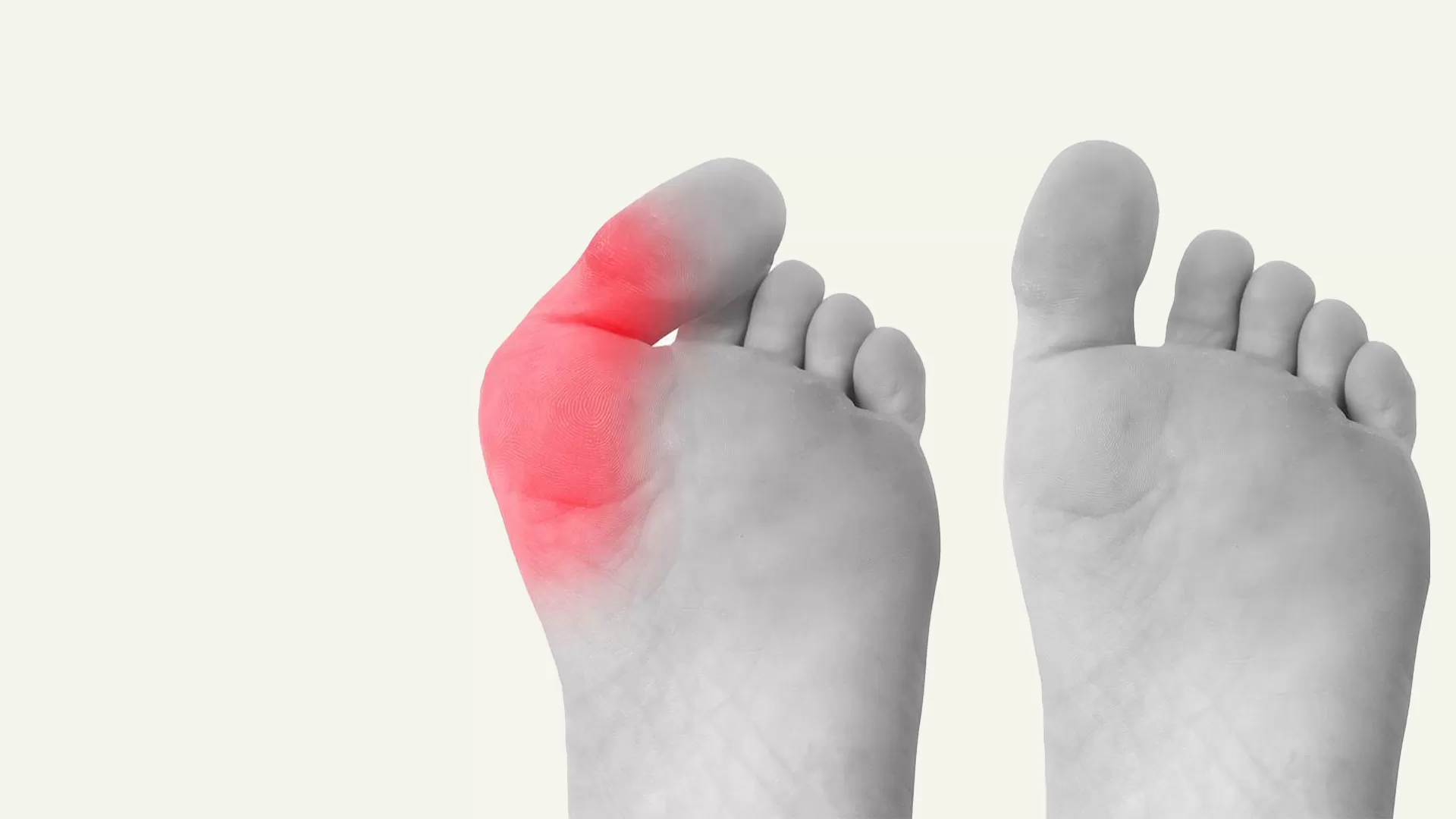

 Arabic
Arabic
 German
German
 Persian (Farsi)
Persian (Farsi)
 Russian
Russian
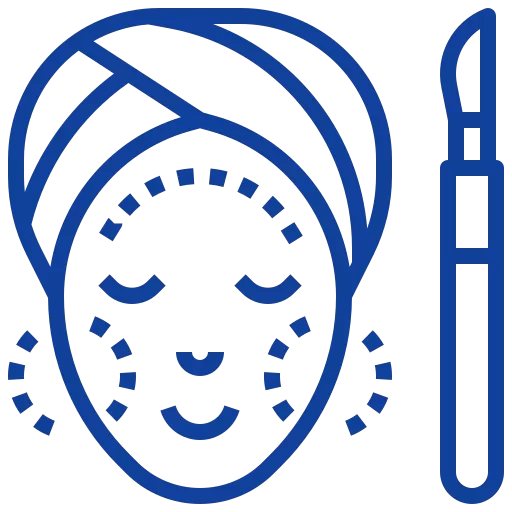 Beauty
Beauty

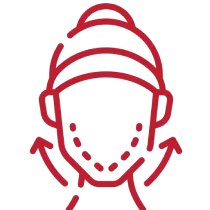
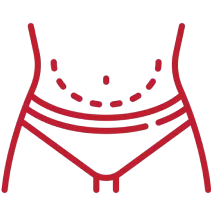
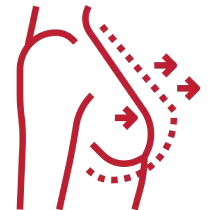

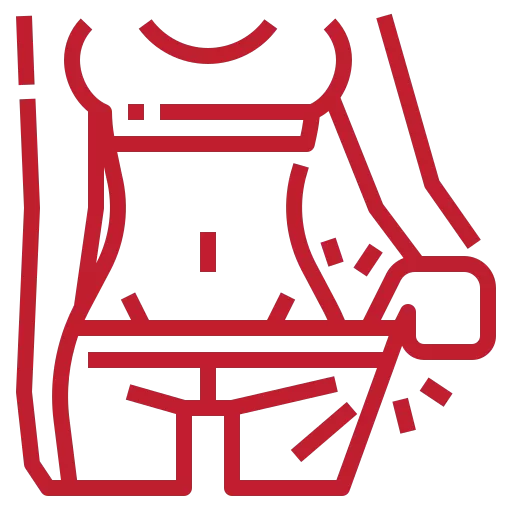
 Medical
Medical



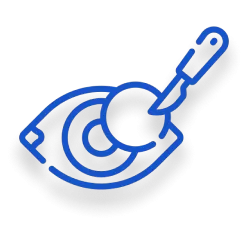
 Hotels
Hotels
 Hospitals
Hospitals






























![Frequently asked question about [name]](/v2tem/images/pages/service/faq-image.webp)
